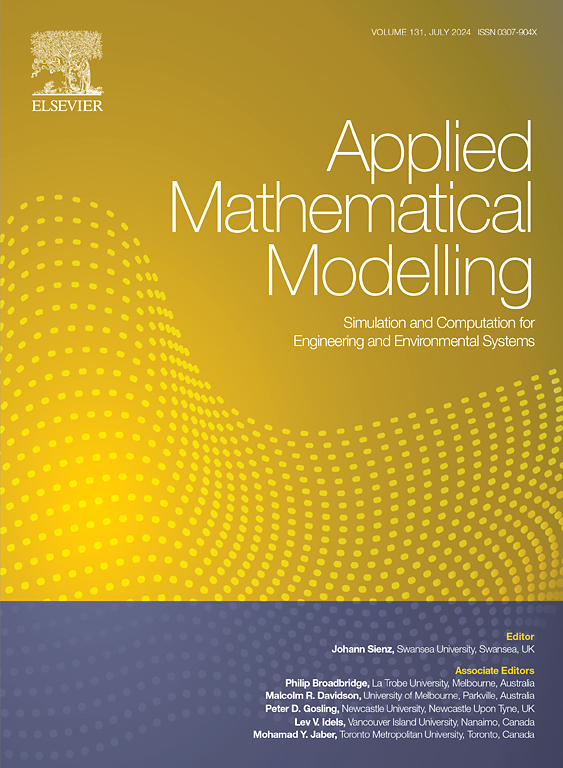Stress-constrained concurrent multiscale topological design of porous composites based on discrete material optimisation
IF 4.4
2区 工程技术
Q1 ENGINEERING, MULTIDISCIPLINARY
引用次数: 0
Abstract
Porous composites have attracted increasing attention in recent decades. This study develops a concurrent multiscale topology optimisation (CMTO) method under a prescribed stress constraint for designing porous composites with multi-domain microstructures. First, to address the difficulty of predicting local stress due to varying of microstructural type throughout the optimisation process, a continuous and differentiable stress measure is proposed to effectively approximate the local stress. Second, an inverse homogenisation method based on isogeometric analysis (IGA) is developed to improve the accuracy of stress prediction, and then it is integrated into a CMTO which is developed based on the discrete material optimisation (DMO) interpolation scheme. Third, a stress constraint which is differentiable with respect to both macro and micro design variables is proposed to enable the stress-constrained concurrent optimisation of the macrostructural configuration, microstructural configuration and distribution. Fourth, a novel post-processing approach is established to achieve smooth while volume preserving contour of unit cells with layouts. Finally, two benchmark design examples, namely l-bracket and Crack problems, are implemented using the presented CMTO under a global stress constraint to demonstrate the effectiveness of the proposed method. The result indicates that the proposed method can effectively decrease the stress concentration via three design manners, i.e., the macrostructural configuration, microstructural configuration and distribution. Also, an “interface-enlarging” phenomenon was interestingly but reasonably found in those cases when subjected to stress-constraint considerations.
基于离散材料优化的多孔复合材料应力约束并发多尺度拓扑设计
近几十年来,多孔复合材料受到越来越多的关注。本研究开发了一种在规定应力约束下的并行多尺度拓扑优化(CMTO)方法,用于设计具有多域微结构的多孔复合材料。首先,为了解决在整个优化过程中由于微结构类型的变化而导致的局部应力预测困难,提出了一种连续可微的应力测量方法,以有效逼近局部应力。其次,开发了一种基于等几何分析(IGA)的反均质化方法,以提高应力预测的准确性,然后将其集成到基于离散材料优化(DMO)插值方案开发的 CMTO 中。第三,提出了一种与宏观和微观设计变量都可微分的应力约束,以实现宏观结构配置、微观结构配置和分布的应力约束并行优化。第四,建立了一种新颖的后处理方法,以实现具有布局的单元尺寸轮廓的平滑和体积保全。最后,在全局应力约束下,使用所提出的 CMTO 实现了两个基准设计实例,即 l 型支架和裂缝问题,以证明所提方法的有效性。结果表明,所提出的方法可以通过三种设计方式(即宏观结构配置、微观结构配置和分布)有效降低应力集中。此外,在应力约束考虑的情况下,还有趣而合理地发现了 "界面扩大 "现象。
本文章由计算机程序翻译,如有差异,请以英文原文为准。
求助全文
约1分钟内获得全文
求助全文
来源期刊

Applied Mathematical Modelling
数学-工程:综合
CiteScore
9.80
自引率
8.00%
发文量
508
审稿时长
43 days
期刊介绍:
Applied Mathematical Modelling focuses on research related to the mathematical modelling of engineering and environmental processes, manufacturing, and industrial systems. A significant emerging area of research activity involves multiphysics processes, and contributions in this area are particularly encouraged.
This influential publication covers a wide spectrum of subjects including heat transfer, fluid mechanics, CFD, and transport phenomena; solid mechanics and mechanics of metals; electromagnets and MHD; reliability modelling and system optimization; finite volume, finite element, and boundary element procedures; modelling of inventory, industrial, manufacturing and logistics systems for viable decision making; civil engineering systems and structures; mineral and energy resources; relevant software engineering issues associated with CAD and CAE; and materials and metallurgical engineering.
Applied Mathematical Modelling is primarily interested in papers developing increased insights into real-world problems through novel mathematical modelling, novel applications or a combination of these. Papers employing existing numerical techniques must demonstrate sufficient novelty in the solution of practical problems. Papers on fuzzy logic in decision-making or purely financial mathematics are normally not considered. Research on fractional differential equations, bifurcation, and numerical methods needs to include practical examples. Population dynamics must solve realistic scenarios. Papers in the area of logistics and business modelling should demonstrate meaningful managerial insight. Submissions with no real-world application will not be considered.
 求助内容:
求助内容: 应助结果提醒方式:
应助结果提醒方式:


